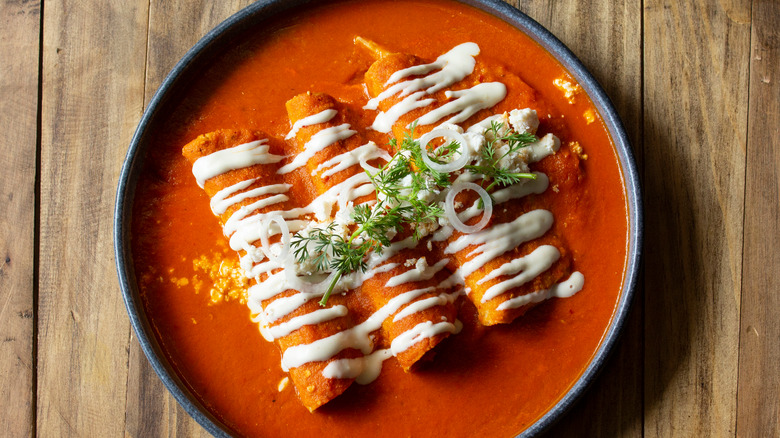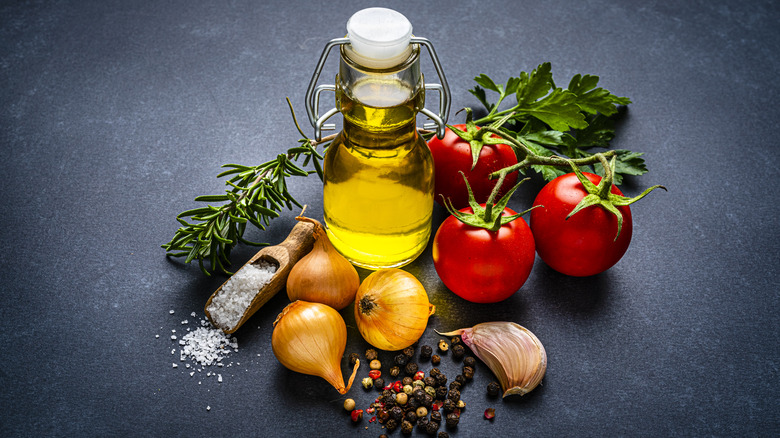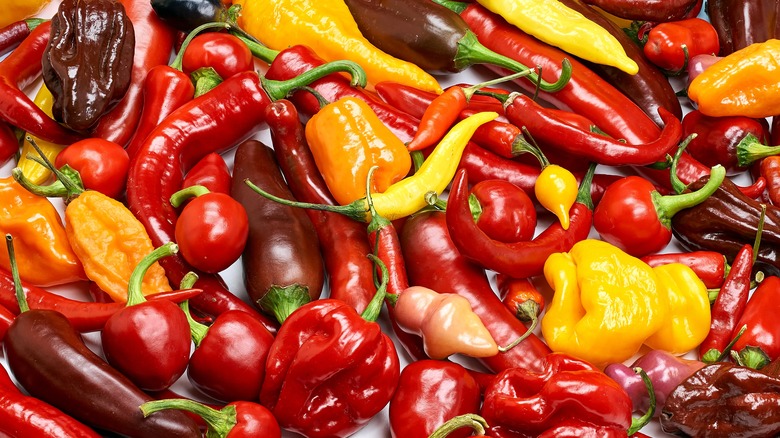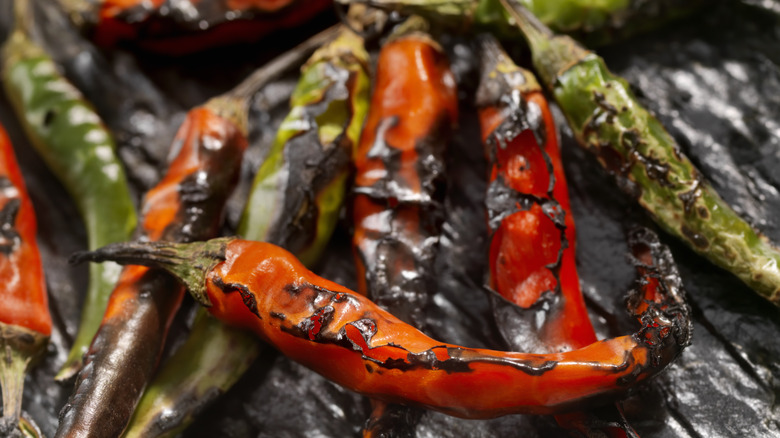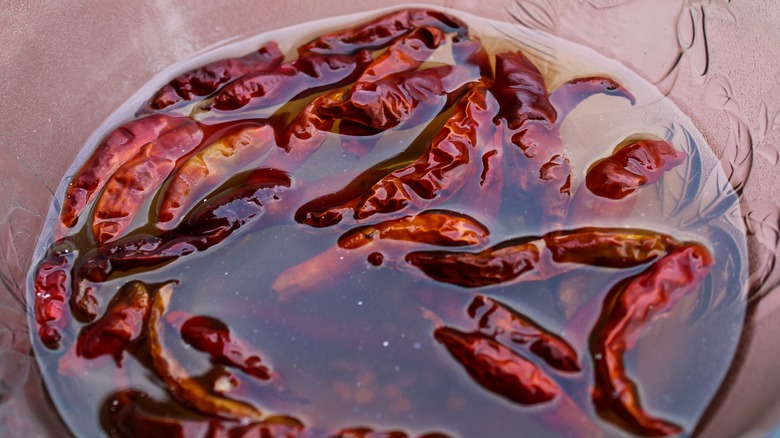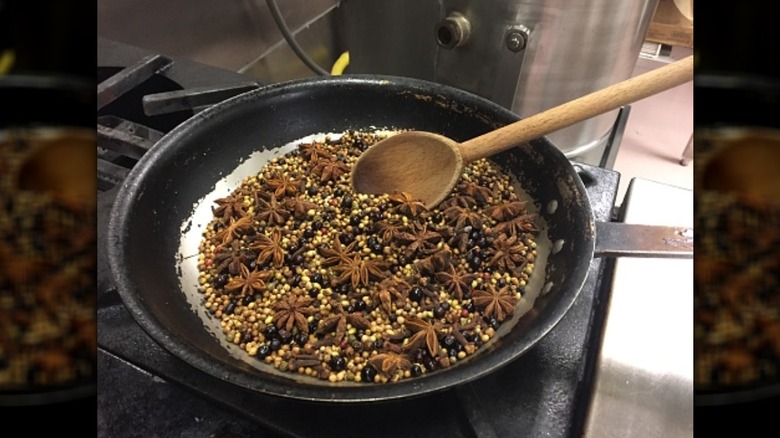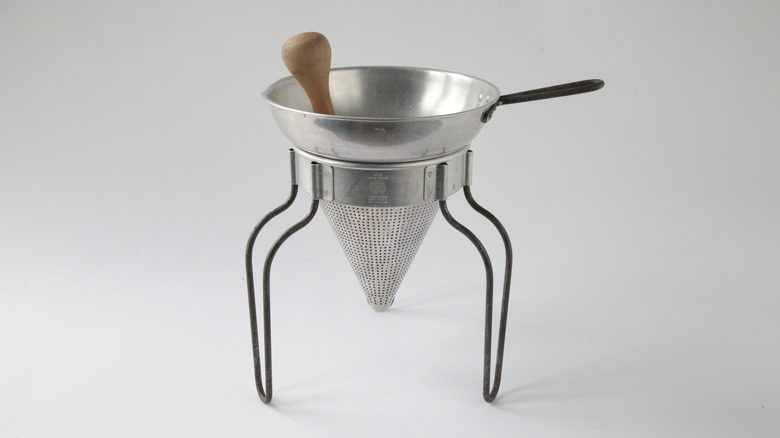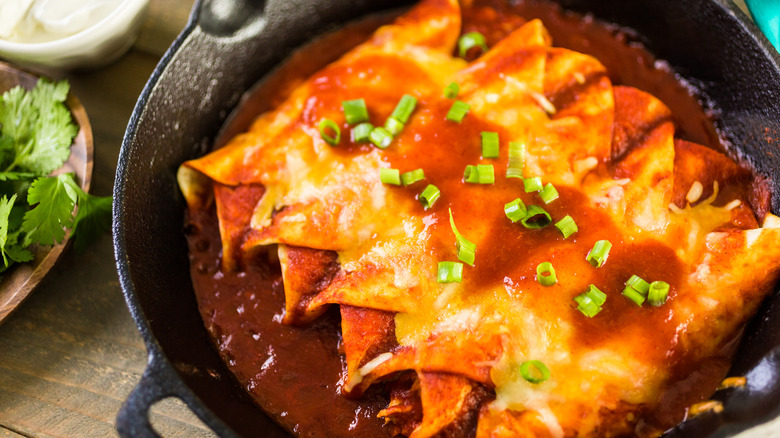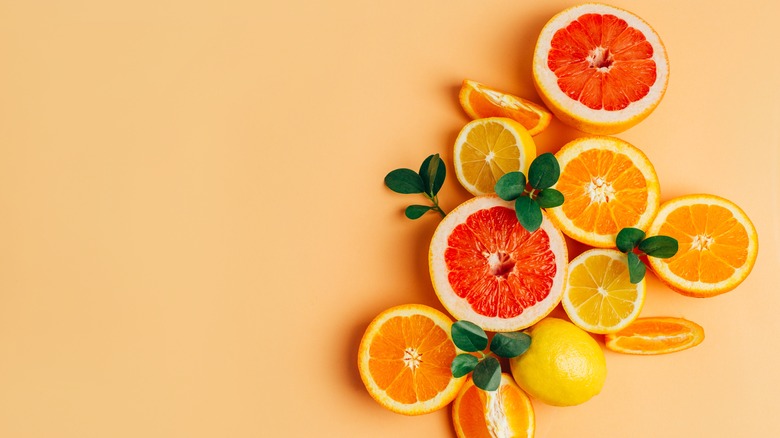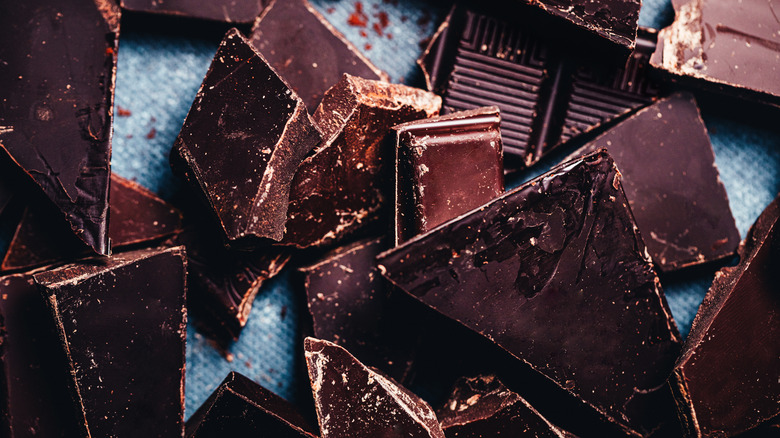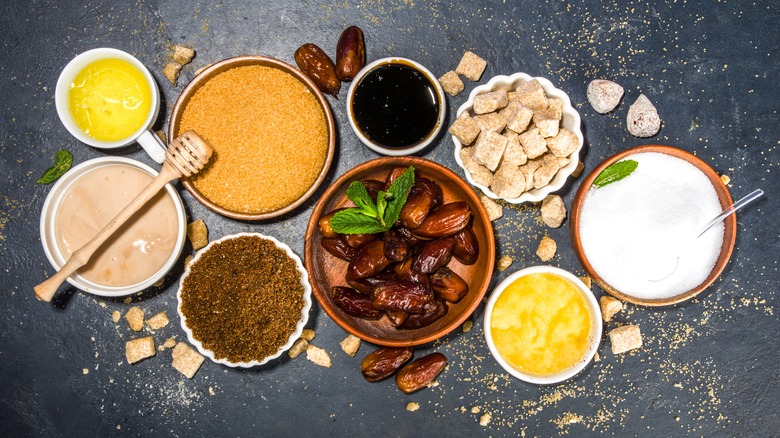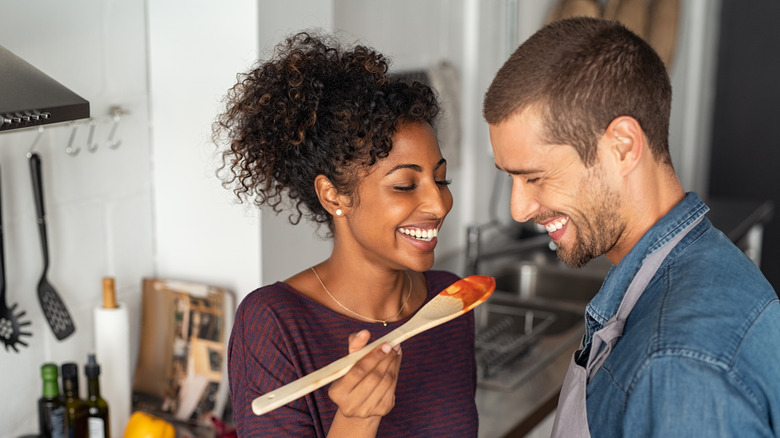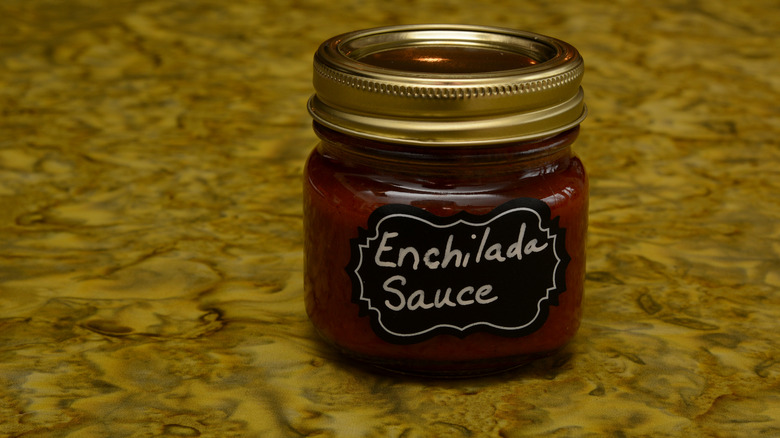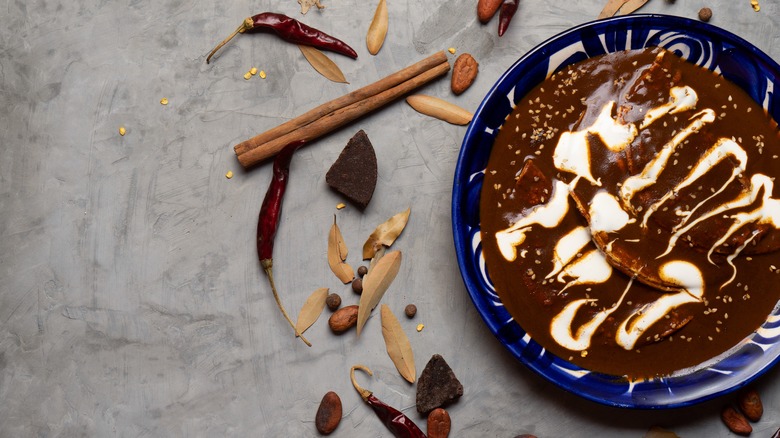13 Tips For Making Delicious Enchilada Sauce
Enchiladas are a humble staple of Mexican cuisine: Corn tortillas wrap around a meat or vegetarian filling and are then drenched with a complex, flavorful sauce. There are two traditional enchilada sauces. Red enchilada sauce (also called salsa roja, salsa roja para enchiladas, or mole rojo) is made from any combination of ancho, pasilla, and/or Cascabel chiles, plus tomatoes. Green enchilada sauce has tomatillos, fresh green chilies, and sometimes additional fresh serrano or jalapeño peppers for more heat. A third variety, white enchilada sauce, uses green chilies and adds cheese, but this is more a feature of Tex-Mex cuisine.
Both red and green enchilada sauces require some time in the kitchen and careful consideration of ingredients. Sure, you could buy a tiny can of enchilada sauce at the store and doctor it up, but that robs you of the pleasure of carefully crafting a customized silky, spicy sauce that's all your own — and homemade enchilada sauce is worth the effort.
The best part about making your own enchilada sauce is the creativity that it involves. Within certain parameters, the flavor variations are nearly endless, and each sauce has its own unique characteristics. When you're ready to join the pantheon of cooks who have undertaken the quest to build their perfect enchilada sauce, here are a few things to consider.
1. Use fresh ingredients
Let's just put this out there: If you're going to use canned ingredients or pre-chopped garlic, you might as well go ahead and just buy the sauce from a can. Yes, some canned ingredients like San Marzano tomatoes are a great solution in the dead of winter when supermarket tomatoes crouch weakly in their plastic clamshell. But when the summer sun is high, nothing beats a just-picked, bursting ripe fresh tomato. These summer tomatoes have a flavor that is unique and a texture that adds to the overall brilliance of the finished sauce. Fresh tomatoes give your sauce a bright and robust flavor that you can't achieve with canned.
The same issues crop up with garlic. Pre-chopped garlic swimming in water or oil is convenient when time is tight, but chances are good you aren't starting your sauce on a busy weeknight anyway. Choose heavy, firm heads of fresh garlic at the store, and look for individual cloves that are smooth, fragrant, and free from blemishes.
If your enchilada sauce recipe uses any other fresh ingredients (such as fresh chiles in addition to dried or fresh herbs), don't think you can substitute a dried version and get the same result. Look for firm, brightly colored peppers that have no soft or wrinkled spots. Fresh herbs should smell deliciously of themselves and have plump stalks. To preserve their freshness, cut the ends of the herbs and store them in water in the fridge until you're ready to cook.
2. Use different types of chiles
The different types of chiles used in enchiladas add not only heat but also flavor to the finished sauce. Any sauce made with a single variety of pepper can become boring in a hurry, and that's the antithesis of this condiment.
If you're concerned about heat level and feel like sticking to the jalapeños and serranos you are already familiar with, take some time to explore dried chiles that are less well-known to you. Branching out to experience different aspects of another cuisine is an important part of making your own enchilada sauce.
Peppers commonly used in red enchilada sauce include ancho, guajillo, or pasilla peppers. Ancho peppers are dried poblano peppers. As they dry, they take on a smoky depth of flavor that can turn bitter if you're not careful with the roasting (more on that below). Guajillo peppers are widely used in Mexican cuisine. They are not as hot as ancho chiles but impart a bright, fruity flavor that lifts some of the heaviness that can cloud enchilada sauce. Pasilla peppers can be very mild or incredibly hot, with a deep, rich flavor.
When selecting the chiles you will use, take care to balance their heat with their flavor. If you only select for heat, you'll have no tastebuds left to detect any nuances in your finished sauce. Keep in mind that you can always add heat when you serve your enchiladas with hot sauce but once finished you can't dial back.
3. Roast your chiles
Dried chiles are not used right out of the box or bag. If you do that, your finished sauce will taste of little more than mildly hot dust. Roasting the chiles until they're charred and blistered will intensify their flavor. This is the first step to waking them from their slumber, and it's critical to get it right. Under-roasted chiles won't be as flavorful, but over-roasted chiles will impart a bitter flavor that is difficult to combat.
Properly roasting chiles can be done in several different ways. First, assemble them on a baking sheet and roast in a 400 F oven for 20-30 minutes. Turn them a couple of times as they roast, being mindful of any hot spots that are getting darker. Another way to roast chile peppers is on an outdoor grill. Preheat your grill to medium heat, then place the chiles directly on the grate. Flip with tongs as they roast, making sure they evenly cook.
Finally, if you have a gas stove with a smooth hot plate, roasting chiles is simple. Heat up the hot plate, and place your chiles directly on top. Again, keep an eye on the chiles for any hot or burnt spots. If you want to add even more complexity to your sauce, roast your garlic in its papery skin and your unpeeled onions at the same time.
4. Rehydrate, rehydrate, rehydrate
Your roasted chiles are now bursting with flavor. It's time to let that flavor release into the sauce, but you'll need to activate it first. To do that, you'll need to rehydrate them.
When your chiles are nearly done roasting, put some water on to boil. Place the roasted chiles in a large bowl and cover them with boiling water. Cover the bowl with plastic wrap to trap the steam inside. You'll notice the water darken as the chiles soften and release all their flavors. When you're ready to make the sauce, remove the hard stems and proceed with the soft chiles. Do not discard the water. Some recipes call for a good quantity of it (instead of or in addition to stock), while others suggest you use the soaking water to thin the sauce if needed.
Note that some recipes suggest you remove the stem and seeds before soaking. This is a matter of preference, but it can be easier to remove seeds and stems after soaking when the pepper is soft.
5. Toast your spices
There are a few techniques that set professional chefs and home cooks apart, and toasting species is one of them. Home cooks typically use ground spices purchased in glass jars from a grocery store, but these come with a particular set of issues. It is difficult to know how old those spices are, and if you have a jar that has been in your pantry for a while, chances are good the flavor is not as intense. You may need to double the amount of spice to get the same result — if that even works.
On the other hand, professional chefs know that using whole spices is the key and that toasting them adds even more flavor. Heating up whole spices in a dry pan (sometimes in oil, depending on the cuisine) brings out the volatile, flavorful oils in the spice. Grinding them just after they've cooled captures that flavorful perfection and transfers it directly to your dish.
To toast spices for enchiladas, warm a small skillet over medium heat. Make sure it's large enough so the spices have room to move. Add your spices in a single layer and toast slowly, swirling the pan for 2-4 minutes until they begin to "bloom." A bloomed spice smells more fragrant and is ready to use. Remove the spices from the heat, allow to cool, then grind the amount you need. You can toast each spice individually if you need specific amounts.
6. Blend and strain your sauce
Your sauce has been cooking slowly with fragrant spices, rich, homemade stock, and all of your softened, delicious chile peppers. Even as each element breaks down and mingles with the others, it's still difficult to know what your flavor profile is. You can only know where you stand after blending and straining your sauce.
You can blend your sauce in a variety of ways. The first and easiest way is to use an immersion blender. This can be placed directly in the pot in which the sauce is being cooked, making for no messy or dangerous transfers to a blender. A blender also works very well, but it can be dangerous if you overload a blender with hot liquid. If you don't have an immersion blender, a countertop blender will work fine — proceed with caution and blend until very smooth.
Once you have blended your sauce, you'll need to pass it through a chinois, a sieve, or a fine mesh strainer. Even the smoothest-looking purée may still contain seeds or bits of chili pepper skin that will be unpleasant to eat. Your goal here is a silky smooth, velvety texture, and that can only be achieved by straining.
You may need to strain your sauce more than once. Depending on the amount of sauce, you may also need to strain it in batches. Once strained, return the sauce to the cooking pot and proceed.
7. Play with consistency
Now is the time to taste the sauce for the first time. You'll begin to dial in the flavor in the next few steps, but first, you'll address the texture. Once you return it to the pot, you might notice the consistency is off. But what is the perfect consistency?
Enchilada sauce should not be overly liquid. A runny texture means that you may not have cooked it long enough to reduce the liquid in the tomatoes, or you may have added a little too much stock. The solution to this consistency issue is to continue to simmer your sauce until it starts to thicken.
If you find your sauce too thick and essentially like porridge after blending and straining, you'll need to add more liquid. Whatever you do, do not just add water. This dilutes the flavor and adds nothing to the final eating experience. If you reserved some of the soaking liquid from your chilies, that's a good option. You can also add additional stock to help thin your sauce.
8. Balance the acidity
Enchilada sauce is not a one-note condiment. The beauty of this traditional sauce is its complexity: the balance of sour, sweet, spicy, and bitter. If you find your sauce feels heavy on the palate and has muddy flavors that don't develop as the flavor lingers, chances are good you'll need to add acid.
Adding acid to food lifts and defines each individual element. Each ingredient becomes more deeply itself so that it can hold its own. When it comes to adding acid to enchilada sauce, you have options. A traditional addition is citrus in the form of lime, but any citrus works. Adding acid with an orange adds a hint of sweetness that can be interesting, while grapefruit adds more bitterness along with the sour.
Some cooks prefer to stir in a splash of apple cider vinegar as the cooking time ends. This is a more neutral option that doesn't lean any one way when it comes to the flavor profile. It's also a good rescue if you skipped this step and can't figure out at the last minute why the sauce tastes slightly off. Before you add salt, try vinegar.
9. Add chocolate to the mix
Chocolate might seem an odd ingredient in a savory sauce, but using cocoa in traditional mole sauce is common. Dark chocolate adds depth, bitterness, and complexity. It also turns your bright red sauce a deep, rich brown.
The trick to adding chocolate is to use a light hand, taking care to balance the bitterness of the chocolate with the other ingredients. Unsweetened dark chocolate or cocoa powder are the usual suspects. Milk chocolate or white chocolate has no place in any type of enchilada sauce. You could possibly get away with bittersweet or semi-sweet chocolate if you are using this addition as your sugar as well.
Another type of chocolate that works well here is Mexican chocolate. This sometimes-unsweetened chocolate has a hint of added cinnamon. The cinnamon is not so pronounced that it boosts itself over the chilies or other ingredients, but it's a soft, underlying note in the finished sauce.
That said, not everyone is a fan of mole-style enchiladas. The visual can be slightly off-putting, it's true. But for some, the addition of this baking ingredient is exactly what they want to take their sauce to the next level.
10. Choose a good sweetener
The best enchilada sauce develops on your palate as you eat. If you tasted earlier in the cooking process and found a bitter or sour aftertaste, this could mean that your chiles or tomatoes are highly acidic and have not had time to tone down. Bitterness is easy to balance with a sweetener, and when it comes to sweeteners, you have many different options.
Agave syrup or brown sugar are two good places to start. Agave is used in traditional Mexican cooking and can keep your recipe authentic while adding a mellow sweetness. Brown sugar is refined white sugar mixed with molasses, and this imparts another layer to the final sauce.
Maple syrup is also an option, as is regular granulated sugar. It is possible to add other sugar substitutes such as stevia or monk fruit, but these can adversely affect the flavor. Monk fruit is very sweet and should be used at half the amount of regular sweeteners, and many people find that stevia has an unpleasant aftertaste. Honey is another natural option that has no aftertaste. A good guide for sweetening is to add half a teaspoon at a time. This prevents you from adding too much.
11. Taste and adjust as you go
Sensing a trend here? The best way to determine if you've used the correct ingredients in the proper amounts is to continually taste and adjust your enchilada sauce.
Cooking changes ingredients. For example, when tomatoes are cooked for a long period of time, their flesh begins to break down, releasing sugars that caramelize. This changes them from an acidic ingredient to a sweeter one. Depending on the variety of tomatoes, the other ingredients present, and how long you've been cooking your sauce, the developing sweetness may mean that adding anything else is unnecessary.
On the other hand, as the liquid evaporates and flavors intensify, you might find that excessive bitter or sour tastes rise to the top. A sauce that tasted pleasant in the first 30 minutes of cooking might change into something entirely different in the last 30 minutes.
Remembering to taste and adjust throughout the cooking time also helps refine your palate. You'll catch subtle nuances of flavor at different stages of cooking — but only if you are constantly tasting.
12. Keep it fresh
Because making enchilada sauce is such a time-intensive process, it makes good sense to cook up huge batches for those days when you have less time. Don't let that hard work go to waste by improperly storing your leftover sauce.
There are several different ways to preserve your enchilada sauce. Before choosing the one that works for you, let your sauce cool completely. If you think you'll use leftovers in a couple of days, store them in an airtight glass container in the refrigerator (plastic containers can become stained and retain the flavor of the enchilada sauce).
Freezer storage keeps your leftovers fresh for even longer (six months to a year). Use ice cube trays or egg cartons to freeze individual portions of enchilada sauce. For family-size leftovers, scoop sauce into plastic freezer bags and remove as much air as possible as you seal the bag. Lay flat in the freezer to save space. Enchilada sauce can also be canned for long-term dry storage. You can either water bath or pressure can — whichever you are more comfortable with.
13. Don't expect the same sauce twice
So many factors affect the flavor of your finished enchilada sauce. The same size dried ancho chile grown in different fields can have wildly different flavors and textures. The same applies to any type of dried chile, onion, or tomato grown in a different state or year. The distance a tomato travels to get to the supermarket also plays a big part in the flavor.
Some of these differences are very subtle, so subtle that you might not pick up on them. The point is that no matter if you follow the exact same recipe with the exact same amounts of ingredients, you might still have a different (still delicious) result.
So why not experiment? The best enchilada sauce is one that suits your palate. Don't be afraid to tweak recipes to your liking, adding more of one ingredient or less of another until you find your perfect blend. You might need to make these subtle adjustments each time you make your sauce. If you like to be methodical, take notes and keep track of which iterations you like the best.
